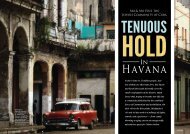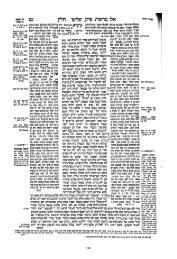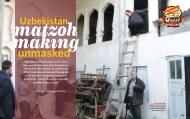The Korban Pesach Of The Shomronim – Samaritans - Halachic ...
The Korban Pesach Of The Shomronim – Samaritans - Halachic ...
The Korban Pesach Of The Shomronim – Samaritans - Halachic ...
- No tags were found...
Create successful ePaper yourself
Turn your PDF publications into a flip-book with our unique Google optimized e-Paper software.
Subject<strong>The</strong> country’s second largestprivately owned commercial mortgagecompany on a transaction volume basisAncient Tribe onthe Mountain ofBlessingTalmudic literature is filled with referencesto the Kutim, or the <strong>Shomronim</strong>. Werethey true converts, or did they convertonly out of fear? Some of the halachicdiscussions include such questions aswhether the shechitah of a Kuti is kosheror whether his matzoh is acceptable. Regardingsome mitzvos, the Gemara assertsthat they were exceedingly carefuland could be relied upon.But most of these discussions wereonly relevant before the big schism, relatedin Chullin 6a, that the Kutim werefound to be worshipping a dove-shapedidol on Har Grizim. <strong>The</strong>y were then declaredto be non-Jews. Rabbi Meir declaredtheir wine as the wine of goyimand their shechitah as that of a non-Jew.From that point forward, halachah hastreated them as non-Jews.If they do consider themselves keepersof the original tradition, why then do theyoffer their sacrifices on Har Grizim andnot in Yerushalayim? Examining theirversion of the Torah together with recentarchaeological excavations on Har Grizimcan explain it. When they first settled theregion, Yerushalayim was in the separateKingdom of Yehudah; later it was inruins. Thus, they ever-so-slightly editedthe Torah, adding a verse after the TenCommandments stating that Har Grizimwill be the location of the permanent altar.After all, Har Grizim is the “mountainof blessings,” where, upon entering theLand, half the tribes stood and deliveredblessings while the tribes on the oppositeHar Eval delivered curses. And in theSamaritan bible, Yehoshua’s altar at HarEval was “moved” to Har Grizim.Archaeologists have actually found theruins of a Samaritan temple built on HarGrizim in the first half of the fifth centuryBCE. That site, with all of the subsequentlydiscovered ruins, was openedwithin the past year to the public as a nationalpark. On display is the stone thatthey claim was the site of the Akeidah,which they also believe took place onHar Grizim and not on Jerusalem’s HarHaMoriah.<strong>The</strong> Babylonians and later the Romansdestroyed the Temples in Jerusalem, butwho destroyed this Samaritan temple?<strong>The</strong> answer: the Jews. In about 128 BCE,the Hasmonean king Yochanan Hyrcanusdestroyed the Samaritan temple that hadstood on Har Grizim for over 200 years.Only a few remnants of it exist today. <strong>The</strong>day of their temple’s destruction is actuallylisted as a holiday in Megillas Taanis.<strong>The</strong> Kutim wanted Alexander Mokdon(aka Alexander the Great) to destroythe Beis HaMikdash, but the decree wasabolished and their own sanctuary wasdestroyed instead.Because of the centrality of Har Grizim,the <strong>Shomronim</strong> direct their prayers in itsdirection and make pilgrimages here ontheir festivals. In fact, the swapping of HarGrizim for Yerushalayim so irked Chazalthat Maseches Kutim concludes with thepassage: “When will we take them back?When they renounce Har Grizim and acceptYerushalayim and techiyas hameisim[resurrection of the dead].”Despite the animosity between theJews and the <strong>Shomronim</strong>, their ranksswelled, and by the fourth century CEthey numbered over a million in the entireMediterranean area, briefly winningindependence from the Byzantine Empire.But subsequent failed rebellions,oppression by the local Arab population,and assimilation thinned their ranks; in1919 there were only 141 <strong>Samaritans</strong> inthe entire world. <strong>The</strong> community hasrebounded, though, and today the <strong>Samaritans</strong>number over 750 individuals.This rejuvenated group is divided almostequally between the city of Holonand their refurbished village overlookingShechem. <strong>The</strong> <strong>Samaritans</strong> in Holon seethemselves as fully Israeli and serve inthe IDF; those on Har Grizim live underthe Palestinian Authority.In recent decades, <strong>Samaritans</strong> have allowedtheir men to intermarry with Jewishwomen, provided that the womanaccepts the Samaritan religion; however,rabbinic authorities never allow intermarriagewith <strong>Samaritans</strong>. Marriage witha Kuti was already prohibited even beforethey were declared full-fledged non-Jews. <strong>The</strong>re are even opinions that a Kutiwho converts is not permitted to marry aJew other than another convert. Becausethe Jewish option isn’t realistic, anotherrecent solution to the shortage of Samaritanmarriage partners is the importationof non-Jewish brides from the Ukraine.PRIESTLY BLESSINGS <strong>The</strong> ancient Aramaic chanting sounds asmysterious today as it did a hundred years agoevery korban have salt on it (Vayikra 2:13). Because they view the matzoh as sacrificialas well, they add salt to the flour-water dough.At this point, many of the Samaritan women and children left while the men continuedto butcher the animals in fulfillment of other commandments. <strong>The</strong>y removedthe right forearm of every animal in preparation for giving it to the priests as gifts,and they excised the gid hanasheh. During this entire process, the head remainedattached because of the prohibition to not break any bones of the korban (Bamidbar9:12). In fact, one young man told us that even when they eat it, they are careful notto break any of the sheep’s bones.Once the whole lambs were put on huge stakes, they were lowered down into thehot pits to cook. <strong>The</strong> fire would incinerate the meat, so as soon as a carcass went in, acloth was put over the pit and children shoveled wet mud onto it. This cut off the supplyof oxygen, putting out the flame and letting the heat do its trick. <strong>The</strong> aroma was abarbecue-lover’s heaven, and now we could dream about what it must have been likein Yerushalayim during the actual Pascal sacrifice.Later, when it was well past dark, the tiny Samaritan community would sit downto their equivalent of a Passover Seder complete with a Pascal lamb. Every single oneof them would be tasting of the korban. Our host admitted that he is a vegetarian buthe, too, would have a little taste, approximately a “quarter zayit,” he told us. Accordingto Samaritan tradition, anyone who does not taste of the meat essentially severshis link to the community. And, because there is no concept of bar or bas mitzvahstatus, even the tiniest infant is given a taste of the korban, just as every weaned childfasts on the <strong>Shomronim</strong>’s only fast day, Yom Kippur.While we knew we were watching a rite performed by a small, non-Jewish minorityliving within our midst, we nonetheless left with a flood of interesting and conflictingthoughts and emotions. Who really was this community? How many of their traditionsare remnants from the ancient practices of our own ancestors? Is this what ourforefathers’ Passover looked like when the Temple stood in Jerusalem, and if not,how did it differ? And most significantly, how does this resemble the future Passoverwhen there will be a rebuilt Temple? As we made our way down the mountain, weoverheard many Jews —who, like us, had come to observe — declaring wistfully thesame thoughts we harbored: “Next year in Yerushalayim!” —62 MISHPACHA 21 Iyar 5773 | May 1, 2013 MISHPACHA 63


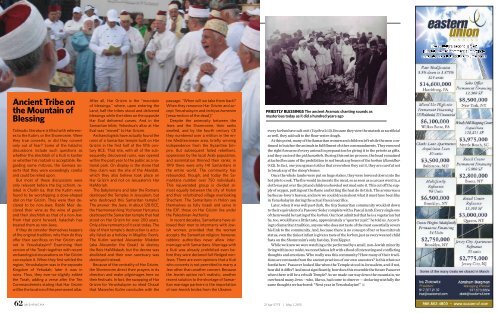

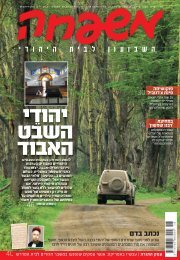
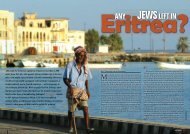


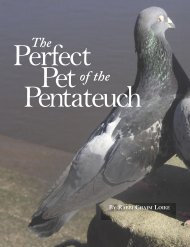
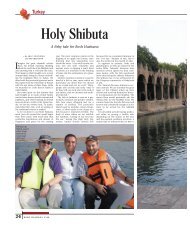

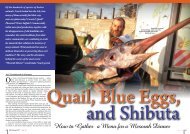
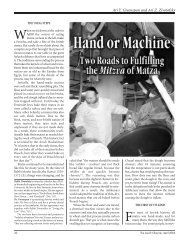
![llVtlwnl 1p1l 1biip 3 K11lnM o1it1 [1] - Halachic Adventures](https://img.yumpu.com/35271577/1/190x253/llvtlwnl-1p1l-1biip-3-k11lnm-o1it1-1-halachic-adventures.jpg?quality=85)
